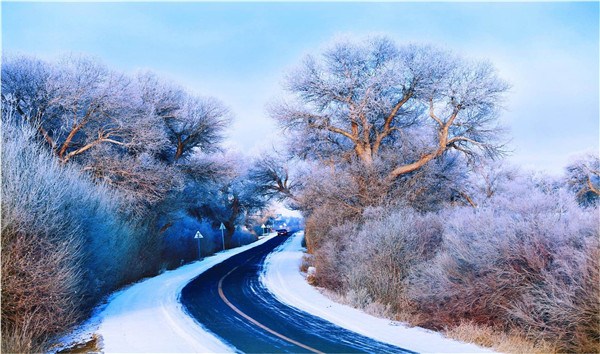
Snow-coated forests in a northern city of Inner Mongolia. Most of the areas in the region are sheathed in snow from October through May. (Photo provided to China Daily)
Camel beauty pageants. Camel rides. Camel herding.
Sheepherding. Mutton-lots of mutton-on kebabs, in hotpot and whole-roasted.
Arm wrestling. Snow wrestling.
Snowmobiling. Snowshoeing.
Swim in -30 C. Boil tea in yurts. Herd reindeer.
Ski down volcanoes.
Shoot arrows. Ride sleighs. Enjoy bonfires in subzero temperatures.
Oh, and don't forget to meet Santa. (He apparently lives in Inner Mongolia.) Get jolly.
This lengthy list of activities is just the tip of the iceberg of the Inner Mongolia autonomous region's wintertime itineraries.
It's a list that ventures far beyond stunning scenery. And there is plenty of that. Landscapes-geological and cultural-are what the region is celebrated for.
Most people think of green grasslands at the mention of Inner Mongolia.
For good reason.
But these are sheathed in snow from October through May, when pink azaleas pop through the white drifts. So, too, are the region's woodlands, hot springs and deserts.
Indeed, Inner Mongolia offers eclectic landscapes, cultures and activities.
Primitive forests cover the Greater Hinggan Mountains in the east. Volcano craters pock-mark many peaks of the Arxan Mountains in the west.
The diversity of wintertime offerings has enticed such travel agencies as CYTS-Linkage Public Relations Consulting Co to conjure itineraries. The company has worked with the region's tourism authority to develop winter routes, executive general manager Ge Lei says.
"The biggest moon I ever saw was at Dalinuoer Lake, where birds sang and danced," Ge says, recalling his first Inner Mongolia visit in 2008.
"But most amazing are the locals. They're tough enough to take down a bear but blush around strangers."
They stage feats of snow wrestling, archery and horseracing, plus performances, folk-art demonstrations and ritual sacrifices, during the winter Nadam festival from December to February.
A growing number of visitors spend Christmas and Lunar New Year holidays in the region to enjoy the celebrations, Hulunbuir tourism authority official Li Jietao says.
Hulunbuir is home to many ethnic groups, including the Mongolian, the Ewenki and the Oroqen.
"Our ethnic culture sets us apart," Li says.
But it's also especially cold.


















































